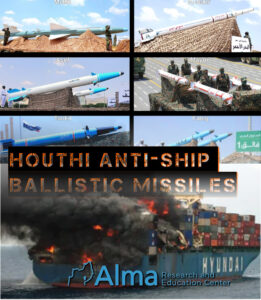 By: Yair Ramati and Yaakov Lappin.
By: Yair Ramati and Yaakov Lappin.
The Houthi movement in Yemen, known as Ansar Allah, exploits its strategic location to launch attacks on vessels in the Red Sea and the Indian Ocean while acting under explicit Iranian orchestration.
Between October 2023 and mid-January 2024 (18.1.2024), the Houthis managed to launch a significant number of attacks against maritime targets: 4 cruise missiles (alongside 6 land attack cruise missiles—LACM), dozens of suicide UAVs (95 in total, some against land targets), a single unmanned surface vessel (USV), and no less than 21 ballistic missiles against ships (anti-ship ballistic missiles, or ASBMs). Those unique ASBM arrived at the Houthis directly from Iran.
Houthi attacks have targeted ships in the southern Red Sea and the neighboring Gulf of Aden, which are joined by the Bab al-Mandab strait, a chokepoint between the Horn of Africa and the Middle East.
In Arabic, Bab al-Mandab means “Gate of Tears”, a reference to the strait’s precarious navigation. The narrow waterway lies between Djibouti and Eritrea on the coast of east Africa and western Yemen, much of which is under Houthi control.
Bab al-Mandab is a strategic link between the Mediterranean Sea and Indian Ocean: exports to the Western markets from the Gulf and Asia must pass through before entering the Suez Canal.
At only 18 miles wide at its narrowest point, shipping traffic is limited to two channels for inbound and outbound shipments, leading to occasional congestion.
Eyal Pinko, a former senior official with Israel’s intelligence services until 2017 who now works at Bar Ilan University’s Begin-Sadat Center for Strategic Studies, said Hezbollah had in particular helped the Houthis to build their naval capabilities.
These include seven naval bases and 30 control posts along Yemen’s coast that have radar and electro-optical directors for better control of missile launches, said Pinko, who has studied the Houthis since 2004.
“It’s a massive coastal defense line for detection, and they’re also using AIS (ship tracking) systems, and also intelligence from Iran,” Pinko said. Automatic identification system, or AIS, is a transponder system that allows maritime authorities and companies to publicly track commercial shipping and identify vessels.
- NAVAL MINES Among the unused weapons in the Houthis arsenal are Iranian-made Sadaf floating mines. While such munitions are relatively unsophisticated and easy to deploy, their impact on merchant shipping would be considerable if they were used in the Red Sea, said Pinko, who also consults on private-sector security.
- Floating mines have been placed with great effect in the Black Sea during the war in Ukraine, sowing alarm amongst shipping companies and their insurers.
- SEE REPORT Reuters has cataloged the ships attacked so far and examined how Houthi militants are using a combination of weapons to target commercial ships. The analysis shows how Houthi drone and missile activity has escalated since the Gaza war began, and has continued despite Western military airstrikes on their bases in Yemen, which began on Jan. 11.
 CLICK TO ENLARGE/ OPEN IN NEW TAB
CLICK TO ENLARGE/ OPEN IN NEW TAB




